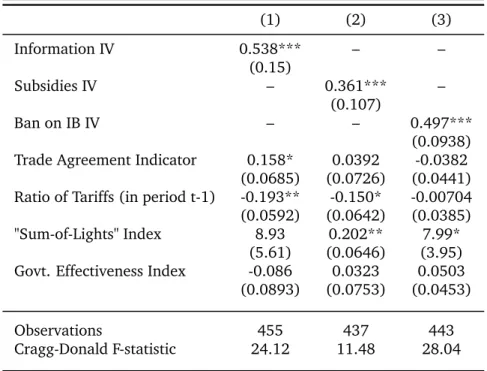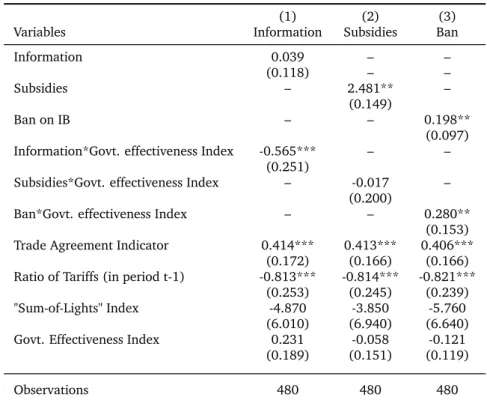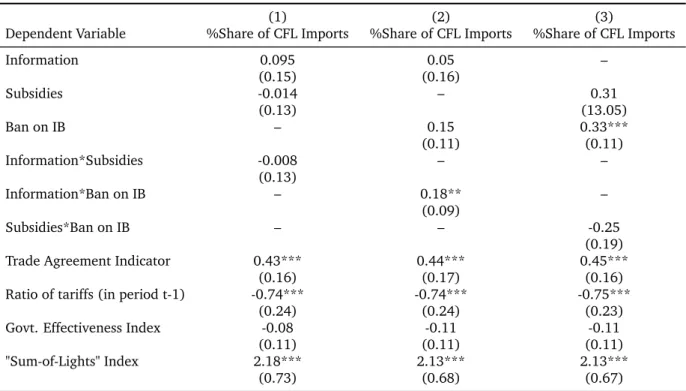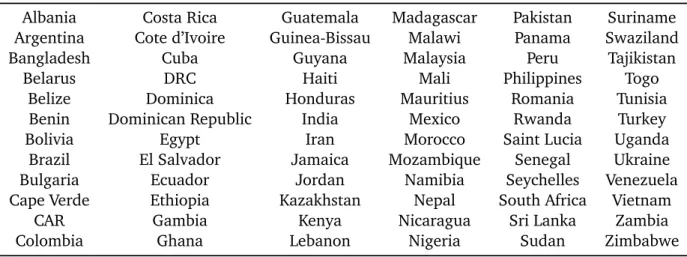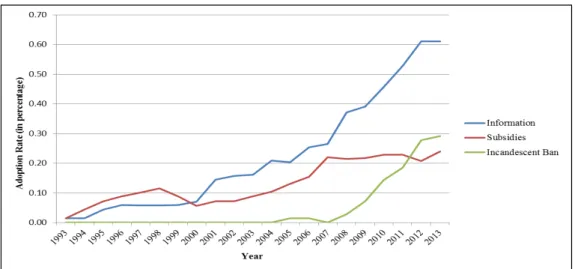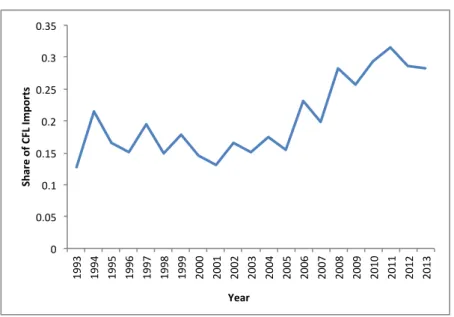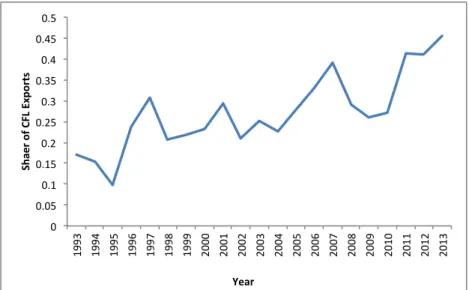The method used in the paper is the instrumental variable two-stage least squares (IV-2SLS) model to study the policy choices of governments in this sample of countries and to study their effectiveness in increasing the adoption of CFL ( measured by the import of these bulbs in relation to the total import of CFL and IB). In the empirical model developed in this paper, the aim is to study the effectiveness of different policy instruments, both when implemented in isolation and together with other policies. The diffusion measure in this article is the amount of CFL imports, since the countries in the sample are not major producers of these bulbs.
Using imports as a measure of CFL diffusion yields the familiar S-shaped diffusion curve, a common finding in the empirical literature. In this paper, spatial variation in policy adoption (rather than adoption of CFL technology itself) is used in constructing an instrumental variable for the (endogenous) policy variables used in IV-2SLS estimation. The second main contribution of this paper is the creation and use of a new data set to assess the utility of different policy options in promoting the spread of CFLs.
The measure of diffusion used in the empirical estimation is the (logarithm of) the import of CFL as a percentage of the total import of IB and CFL, measured in terms of weight (in tons). Since the diffusion measure used is lamp imports, it is imperative to control for trade policy measures in the empirical estimates. Figures 3 and 4 show the share of CFL imports and exports over time in the sample.
The increase in the share of CFL exports over time suggests that some of these countries may have become producers of CFL.

Methodology and results
The instruments used for policy tickets are constructed as weighted averages of the presence of the same policy in one of the five closest countries to the one in question, where the weight represents the country's distance from the neighboring country. To account for these probabilities, the instrument is a weighted average of the presence of a policy in the five countries closest to the given country either in period t, in period t-1, or in period t+1. However, it is difficult to identify another channel through which the adoption of policies in neighboring countries can affect the share of CFL imports in a country, other than through its influence on a country's decision to adopt the same policies.
The share of CFL imports should not depend on the policies implemented in other countries, provided that none of those countries are themselves large producers and no country imports an unusually large amount of CFLs. For the reasons already mentioned, the IV-2SLS results are the basic results of the paper. In the first column, the coefficient on information provision is positive and significant at the five percent significance level, suggesting that for this sample, information policies actually work in promoting CFL imports.
The total lights variable also has a positive coefficient, suggesting that countries that are more developed are more likely to have higher CFL imports. The ratio of the tariff variables behaves as before, while the coefficient on the sum of night lights is positive and significant at the five percent level of significance: the greater the number of night lights, the greater the percentage of imported CFLs. by country in a given year. In this specification, the trade agreement indicator is also significant at the five percent significance level with a positive coefficient: if a country has a trade agreement with one of the largest CFL exporters in a given year, it is more likely to import a larger share of CFLs in that year.
Although there is no specification that includes all these policy dummies together, a comparison of the size of the coefficients of the policy dummy from these three models shows that subsidies are the "most efficient" policy instrument for this sample, followed by the IB ban, and lastly information provision. Table 3 below presents the results of the first-stage estimates (first-stage results are reported only for the results corresponding to columns one, three and five of Table 2). Additionally, if a country has a trade agreement with one of the largest CFL exporters in a given year, the country is more likely to implement information provision to encourage consumers to adopt CFLs, suggesting that factors that facilitate access to technologies strongly related to policy makers' decision to inform consumers.
Column three presents the results of estimating governments' decision to ban IB: again, there is strong evidence to suggest that the decision to ban the import or sale of IB depends positively on whether neighboring countries have also imposed this policy (coefficient on the instrument is positive and significant at the one percent significance level). In the results of Table 4 below, the policy models are presented as an interaction variable along with the government effectiveness index to test whether the efficiency with which these policies are implemented can affect the share of CFL adoption. Thus, the interpretation of the coefficient on the main effect represents the marginal effect of the policy when the implementation of the policy is ineffective, and the coefficient on the interaction term represents the marginal effect of the policy when it is effective.
Column 1 of Table 4 shows the results of the estimates for the information policy. The effect of the information policy in the case of ineffective governments is to increase the share of CFL imports by 20.4 percent, whereas the effect of the policy is for effective governments.
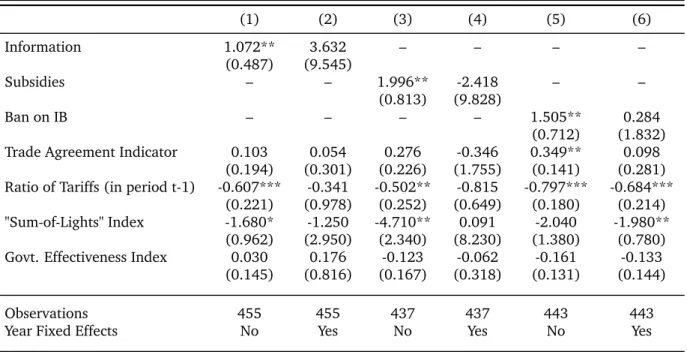
4 Policy implications
It is interesting to compare the results of this paper with those offered by the literature on developed countries. 2009), for example, using Swiss research data, provide policy implications of successive policies to encourage consumers to buy green cars. They find that information provision policies (such as car energy labels) can be more effective if introduced early in the diffusion process in encouraging green consumers who are concerned about the environmental consequences of their actions to adopt green cars. However, financial incentive schemes (such as subsidies or fines) and regulatory "sticks" may later be more effective in providing incentives for less environmentally motivated consumers who need monetary incentives to adopt the technology.
Allcott and Taubinsky (2015) find that among US consumers of pure pears: information provision is the first best welfare policy, the second is a subsidy, while a ban is unlikely to lead to an improvement in consumer welfare. The paper also finds a positive role for trade policy in encouraging the adoption of clean technologies. For example, trade agreements with the largest exporters of certain technologies can facilitate technology transfer.
First, the empirical model shows the implementation of policies in the sample of countries using dummies, bypassing the extent of the implemented programs or any geographical disparities. In addition, it is also unable to account for any delays between the publication of the policies and their implementation. This may be particularly relevant in the case of the ban on incandescent light bulbs, because there is sparse data on the dates of announcement of the incandescent ban for the countries represented in the sample.
Mills and Schleich (2014) use data from a German survey to find that households stockpiled incandescent bulbs after the policy was announced and before the ban was actually implemented.
5 Conclusion
However, subsidies remain the most effective tool, suggesting that cost-related barriers are the most important (at least for this particular technology). Furthermore, a policymaker's decision to implement policies depends on the experiences of other (similar) countries, the effectiveness with which these policies can be implemented, and the amount of resources available to the policymaker to implement these policies. Regarding the possible complementarities between policies, governments with more resources available for energy efficiency policies may be better off using them to implement subsidies, at least in the short term, while governments able to Effectively implemented policies can benefit from banning old technologies, while simultaneously providing information to consumers about new technology (as they have been found to be complementary policies).
Finally, this paper concludes that policymakers seeking to encourage consumers in developing countries to adopt new technology would benefit from considering the effectiveness of different instruments relative to their resources and policy environment and learning from similar experiences. countries.
6 Appendix
Dependent Variable % Share of CFL Imports % Share of CFL Imports % Share of CFL Imports % Share of CFL Imports.
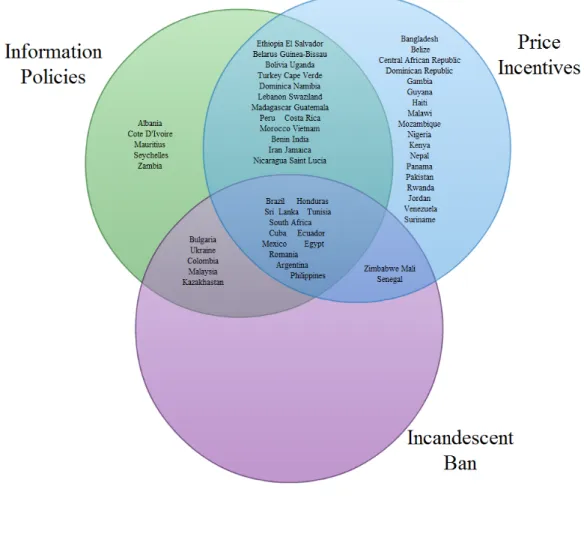
Lefèvre, Nicolas, P T'Serclaes and Paul Waide (2006) "Barriers to technology diffusion: the case of compact fluorescent lamps", Joint OECD and IEA Paper, Paris, pp. Mansfield, Edwin (1961) “Technical change and the degree of imitation,” Econometrica: Journal of the Econometric Society, pp. 1968) “Industrial research and technological innovation; an econometric analysis.” Mills, Bradford F and Joachim Schleich (2010 ) "Why Don't Households See the Light?: Explaining the Diffusion of Compact Fluorescent Lamps," Resource and Energy Economics, Vol.
Papageorgiou, Chris, Andreas Savvides and Marios Zachariadis (2007) “The Diffusion of International Medical Technology”, Journal of International Economics, Vol. Reppelin-Hill, Valérie (1999) “Trade and the Environment: An Empirical Analysis of the Technological Effect in the Steel Industry,” Journal of Environmental Economics and Management, Vol. Staiger, Douglas O and James H Stock (1997) “Instrumental Variables Regression with Weak Instruments,” Econometrica, Journal of the Econometric Society, Vol.
